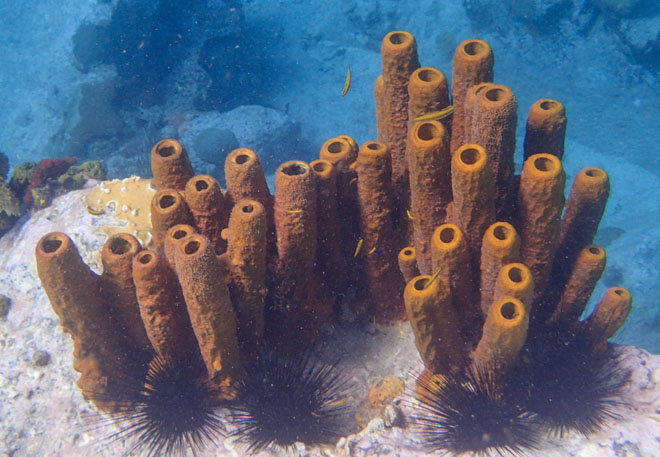
The whole purpose of this blog is to bring people with me on a journey as I write a short story collection called Animal Stories—a collection in which the first story will be narrated by a single-celled organism, and the last story narrated by a human being.
I began the collection way back in 1995, but drifted away from it around 1999, and then resumed work on it again until earlier this year. And when I resumed that work, I did so by writing the first story for the collection. That’s right, this year I wrote a short story narrated by a single-celled organism.
The story is called “The Second Proliferation,” and I will soon be giving it a final revision and then seeking publishers for it.
In this blog post, I will describe the writing of that story.
First thoughts about the story
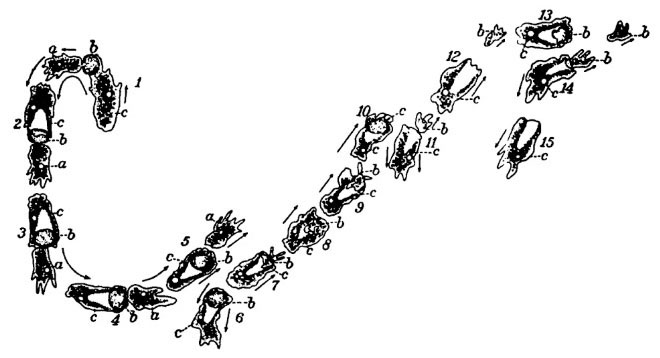
My intention to write a story narrated by a single-celled organism goes all the way back to 1995, when I wrote the first of the stories for my Animal Stories collection. That first story was about ravens (inspired by a 1995 article about ravens by naturalists Bernd Heinrich and John Marzluff). And that led me to the idea of writing a collection that covers the diversity of animal life. And that, in turn, led me to the idea that my first story for the collection should be narrated by a single-celled organism.
But how to write a story about a single-celled organism? At first, I struggled to come up with ideas.
In thinking about what single-celled organism I wanted to write about, my first idea was to write about an amoeba. Among the main “protozoa” classifications I learned about in high school (amoebas, flagellates, and ciliates), I had always found amoebas to be evocative and weirdly charismatic. And though I can’t say why I thought this, I don’t think I was the only one. For example, Gary Larson’s Far Side includes plenty of amoeba cartoons, like the one where an amoeba in a cowboy hat says, “Adios, amoebas.”
And so, way back in the late 1990s, I tried doing some preliminary research for a story about an amoeba. Some books I found cited the 1904 book Behavior of the Lower Organisms, by Herbert Spencer Jennings. Since my research demands that I read things that engage my imagination about these kinds of organisms, and doesn’t demand that my reading materials be recently published, I found a copy of the 1904 book and read about how the author tried to cut an amoeba into two parts using a glass rod, and how a second amoeba then came came along and engulfed one of the parts. I thought about how something like this might be turned into a story, but the idea didn’t go anywhere, and I didn’t write the story. With hindsight, that was probably a good thing.
A story about the evolution of sponges
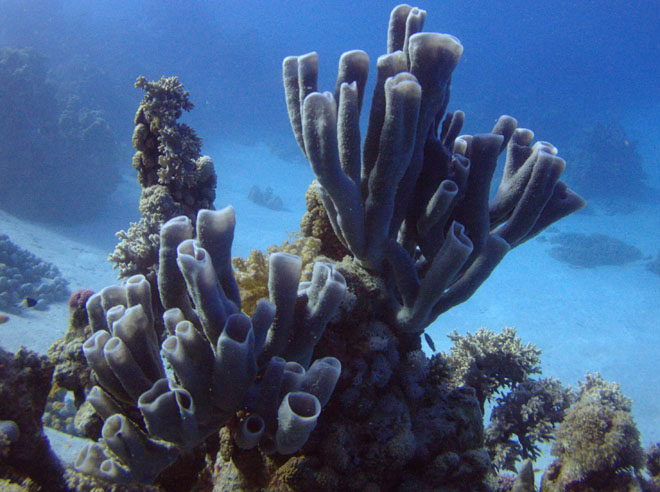
About twenty years went by, as I described above. For most of those years, I drifted away from the idea of writing the book, but nevertheless, during those years some part of that idea still kept hold of my imagination. One of my thoughts was that if that first story wasn’t narrated by a single-celled organism, it would have to be narrated by a sponge, the simplest kind of animal. Then, eventually, I came to the idea that it could be a story about both—about how single-celled organisms evolved to create the world’s first sponge.
It wasn’t a straightforward idea. The problem with writing about evolution is, it happens on such an inhumanly long time scale that during it into a comprehensible story isn’t easy, to say the least.
(Douglas Adams might make a joke about organisms with “unstable chromosomes,” so that they “quite frequently evolve several times over lunch,” and that might work as a joke, but it wouldn’t work very well for a short story that has any kind of mooring in reality.)
Nevertheless, “not easy” doesn’t mean “impossible,” and the idea kept pressing on my mind. Although it’s a little weird for me to think about it now, I actually did some half-hearted research into this during the period when I didn’t think I was going to write the story or the book. I found out that there is a type of living protozoa that scientists have identified as by far the closest living relative of sponges and all other animals. Scientists refer to these protozoa as choanoflagellates. Interestingly, not only in genetic makeup, but also in physical appearance, these choanoflagellates bear a surprising resemblance to certain sponge cells called choanocytes.
A story about the development of human civilization
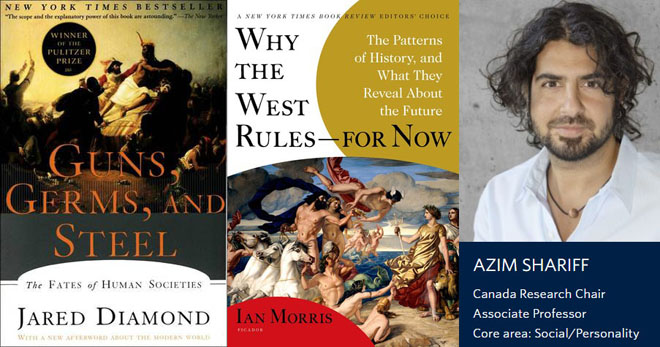
But it wasn’t enough just to write a story about how certain flagellates evolved into sponges. There had to be a point to the story, a reason for telling it.
Eventually, the idea came to me: the evolution of single-celled organisms into sponges might be seen as analogous to the way human tribes came together to build the first cities and civilizations.
And by June 2018, that was where I was at. I had conceived of all the ideas above, but that didn’t give me enough to begin writing the story. I knew I wanted to model the evolution of single-celled organisms into sponges after the development of human civilization, but knowing didn’t give me a clear enough picture of how human civilization developed. What I needed was a book or something to provide a simple explanatory framework for how civilization itself began. Piece of cake, right?
A few books have attempted this. One of the more famous examples of the last few decades was Guns, Germs, and Steel, which I’d read before, but didn’t quite help me enough. In looking for other examples, I found Why the West Rules—For Now, by Ian Morris, which provided a theoretical framework to explain human history, but just didn’t quite do what I needed. What I needed was to have the end of the stone age and the beginning of civilization boiled down into one or two simple ideas.
Then, in August 2018, I got a lucky break. I ran across an episode of the Hidden Brain podcast, one in which they interviewed social psychologist Azim Shariff as he described his studies of ancient civilizations. Shariff said that, among all the civilizations of the ancient period, the ones that succeeded the best were often the ones believed in a powerful god(s) that took an interest in punishing people who steal, cheat, or otherwise step out of line with the needs of larger societies. Shariff pointed out that, for the vast majority of the human race, people lived in groups of no more than about 150 people, in small tribes where no organized mechanism of law enforcement is needed, because everyone knows everyone else. Later, however, when it became advantageous for people to build large cities, those cities needed some kind of glue to hold society together. Shariff claimed that religion provided that glue, encouraging people to cooperate, and in so doing serving the incredibly important pro-social function of allowing people to live in large cities for the first time.
I found this a plausible idea. It painted a picture that was clear, and offered storytelling possibilities. I decided to go with it.
Learning the science
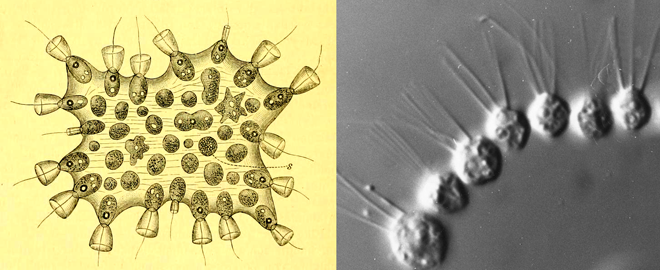
This cleared away my biggest hurdle, but I wasn’t ready to get started quite yet. It was all well and good to say that my story intended to talk on a figurative level about the development of human civilization, but if it didn’t first succeed on a literal level, nobody was going to care. My next step, then, was to learn about the unicellular organisms I was going to be writing about.
In fact, I had started this process at least as early as June 27, 2018, when I posted a question on biology.stackexchange.com: “What did the evolution of multicellular animals look like?” I asked for transitional forms that would help me understand the process. As I look at my question now, it seems hopelessly naive, but that is the nature of attempting to figure these things without a college-level training in biology. I am highly appreciative of Ben Bolker, Karl Kjer, and Martin Klvana for their responses.
With their help, I found a 2010 article by Stephen M. Miller that tells of a single group of green algae—Volvox and its relatives—a group that contains both unicellular and multicellular forms, and a group that is as close-knit as a family, believe it or not. The article also describes the simple form of multicellularity in Volvox, which really contains only two types of cells. (To be more specific, the multicellular genus Volvox and the unicellular genus Chlamydomonas are in either the same family (Volvocaceae), or else at least the same order (Chlorophyceae), depending on which source you follow.)
The cool thing about scientific papers is that they contain references to other scientific papers. Following the references from the Miller article, I found a 2004 article by Nicole King that turned out to be my most useful source, introducing me to a few new ideas for the first time, such as the idea that becoming multicellular might have served as a defense mechanism of sorts, allowing small organisms to become bigger and thereby to become harder for predators to ingest. Nicole King continues to run the King Lab at Berkeley (and the lab’s Twitter feed is well worth following if this subject interests you).
Another source that helped me was the revised and expanded edition of The Ancestor’s Tale, by Richard Dawkins and Yan Wong, a book that includes not one but multiple relevant chapters on choanoflagellates and sponges. In addition to many valuable bits of information, it also includes an artist’s depiction of a possible transitional form between choanoflagellates and sponges—a depiction that stuck with me and influenced one of the segments of my story.
Finally, near the end of my research process, I found the BBC documentary First Life, which introduced me to the possibility that there may have been a major ice age prior to the period when animals first evolved, and that that ice age may have influenced the timing of the evolutionary process. (When I tried to corroborate the documentary’s claims, I found it difficult to get the geological/evolutionary timeframes to line up, but I decided to roll with the ice age hypothesis anyway. As an author of a work of historical fiction, I have that liberty.)
By the time I found all these sources, I was well on my way. They, plus Wikipedia and an untold myriad of other web sites, gave me just enough information to complete my story.
The actual writing of the story
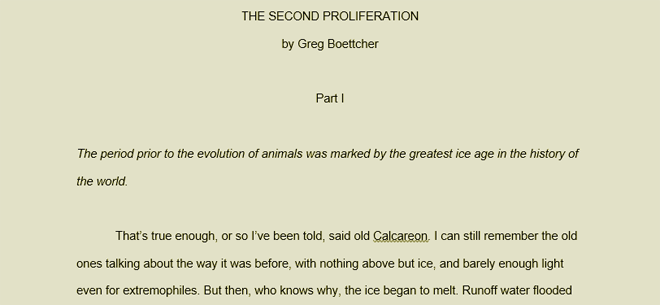
That takes me through just about everything I wanted to get to, except the actual writing of the story, which went as follows.
As of June 2018, I knew I wanted to resume work on my short story collection after about 19 years of letting it go. I had heard of a mastermind group (an online discussion group with many videos of encouragement from the mastermind’s organizer) and signed up for it. The mastermind began July 1, and I spent July working on an unrelated project, but by early August, I was ready to begin work.
On August 6, I began a final ten-day period when research on the story was the most important priority in my life, and I completed the research at the end of those ten days. For those days, I filled in the final gaps of my understanding of sponge physiology, the sequence of geologic and evolutionary events during the Proterozoic, and so on. It was also during those days that I luckily landed on the Hidden Brain podcast and the BBC documentary mentioned above.
On August 16 (my 42nd birthday), I began the first draft of my story.
By August 29, I had completed a first draft of what ultimately turned out to be Part 1 of 3 of my short story. Instead of continuing on and completing the first draft, I decided to start by doing a second draft of that first part, so that I could submit that part as a writing sample as part of an application to a workshop I wanted to attend at the Loft Literary Center in Minneapolis. I completed my second draft of that first part on September 3 and submitted the writing sample on that day.
Although at that point I had completed what I now know as the first third of my story, that wasn’t what I thought at the time. I thought I had completed the first two-thirds—! Finding out I was wrong about that, and that my story would have to be longer than I thought, was the most unexpected aspect of writing the story.
For me to go into this, I have to describe that first segment of the story (the part that I then thought of as the first two-thirds, but which I now know as the first one-third). This segment quickly introduces the reader to flagellate organisms, and to the story’s two main characters, a couple of flagellates named Calcareon and Porfirio. (The names are both taken from various scientific sponge names.) The segment describes the way these flagellates had to change their way of life due to changes in their environment, particularly by the way their predators (amoebas) kept getting bigger and stronger. And it describes how, in the course of doing this, they stumbled across a strategy of building colonies on the ocean floor. There was strength in numbers, and they were usually able to be safe from predators that way.
And after I had written all of that, I figured all I had to do was the comparatively simple job of describing how these flagellate colonies grew from very small (probably just a little too small to see without a microscope) to rather large (a foot or more tall). How hard could that be?
It turned out that the remaining portion of the story was not just harder than expected, but very hard indeed, because that was where all the drama and conflict really was. The story’s narrator wants to keep things simple and peaceful, while other character wants to keep on building their colonies to be as big as possible, at whatever cost. To flesh out this conflict and resolve it took four times more space than I’d originally expected, but by the time I was done, the story was quite satisfying to me, and I’ve received good feedback on it.
To complete the latter two-thirds of the story in first draft took me until September 24. To complete a second draft of it took me until November 9. I think the story may need another quick revision or two, but it is mostly done now. Soon I’ll submit it for publication.
The future of the story

As described immediately above, I haven’t yet submitted the story for publication. This story, about single-celled organisms called choanoflagellate that will one day evolve into sponges, is called “The Second Proliferation.”
I’ve gotten a good response on it from those who have read it, including the other students in my workshop class, as well as my instructor. And I’m pleased to say I feel I fulfilled my own high expectations for the story; it’s my best work to date, I think.